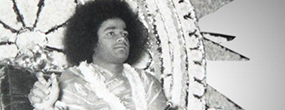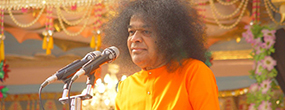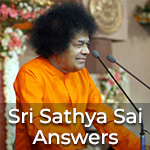The Answers to All Your Questions
Q. What should be the undercurrent of all Samiti activities?
Love is the solvent for the hardest of hearts. Without love, free, full and selfless, no spiritual Sadhana can succeed. Without it, Bhajan is waste of breath, Satsang, a waste of time and meditation a self-deception. Bhajan, Satsang and meditation done with a mind soaked in love, can confer peace, joy and wisdom. When the rain drop falls into the sea, it gets the name, form and nature of the sea. So, too, when the individual merges in the vast concourse of humanity and feels one with all, he is endowed with the name, form and nature of Divinity. Whatever you do as service, to whomsoever you offer the act, believe that it reaches the God in that person.
- Sixth All India Conference, Prasanthi Nilayam | November 14-22, 1975
Q. What is the relationship between the Samiti and various units under its administration?
Each town shall have a single Samiti (organisation and unit); it shall not have more than one. It may have within its jurisdiction a hundred Bhajan Mandalis or a hundred groups engaged in various other activities. But there shall be only one Samiti... Units like Sathya Sai Satsang, Sathya Sai Bal Vikas, Sathya Sai Study Circle, Sathya Sai Bhajan Mandali, and Sathya Sai Seva Dal will be subordinate to the Samiti and supervised by it. The Samiti is the heart, and the units are the limbs. The limbs cannot act independently, as if they are a law unto themselves… The Mahila Vibhag will be under the guidance of the Samitis concerned. Of course, the Vibhag can have its own Chairman and Secretary, but both must follow the advice and suggestions of the Chairman of the Seva Samiti, and the rules laid down for the Samiti.
- Fourth All India Conference, Madras | December 22-23, 1971
Q. What kind of Samiti activities can be organised for spiritual uplift of its members?
Establish unity among yourselves first; do not seek faults in others or excellences in your own selves. The Fatherhood of God and the Brotherhood of Man – have full faith in this and fill every act of yours with that reverence and love. Meet together once a week or once a fortnight or at least once a month; have someone to discourse to you or engage in Bhajan or study or Dhyana; experience the thrill of spiritual comradeship. Every member of the Organisation must have some item of work allotted to him and he must be present whenever such meetings are held, unless of course it becomes physically difficult.
I must tell you about another point also. Wherever you are, whatever work you do, do it as an act of worship, an act of dedication, an act for the glorification of God who is the inspirer, the witness, the Master. Do not divide your activities as, “These are for my sake” and “These are for the sake of God.”
When you work, there should be no remainder, nothing should remain over. See all work as one. You should not, the Shastras say, leave any remainder or balance in debts, in disease, in vengeance against enemies, in the cycle of birth-death. Finish all, down to the last. They should not recur. If you offer all activities at the feet of the Lord and free them from any trace of egoistic attachment, the consequence will not bind you: you are free, you are liberated, you have Moksha.
- First All India Conference, Madras | April 20-21, 1967
Q. Which festivals should the Sai Samiti celebrate?
The Bhajan Mandalis, Satsangs, Bhakta Mandalis, that are now established must spread the message of Nama Smarana, Bhajan and Nama Sankirtana at all times and in all places. Jayadeva, Gauranga, Thyagaraja – all these moved through the Bazaars and streets, singing Bhajans and songs about the glory of God and their ecstasy filled lakhs and lakhs of people with Divine fervour… Yesterday, someone read out a list of holy days which the associations were to celebrate. That list mentioned Shivaratri, Navaratri, Swami’s Birthday and Guru Poornima. But you must also celebrate the Birthdays of the Mahatmas who led man to the God within, and also all days held holy by your brothers. Do not set limits to these celebrations and these days. Make every day a holy day and fill it with the recollection of God and His Messengers.
- First All India Conference, Madras | April 20-21, 1967
Q. How should Members belonging to other religions participate in activities?
Here is another question from a Muslim who is the Vice-President of the Sathya Sai Seva Samiti, in his town. He asks whether he can partake in the Nagar Sankirtan, Dhyana, Puja, etc., that the Samiti is having on its programme. If he desires, he can; if he feels that it goes against his inner conviction, he need not. One should not give up his conviction in the face of ridicule or persecution. He can carry on Dhyana according to his conviction in the privacy of his own home; there is no compulsion that he should thrust them on the attention of others, outside. All faiths are inter-related and mutually indebted to each other for the principles they teach, and the disciplines they recommend. The Vedic religion was the first in time; Buddhism which appeared about 2,500 years ago, was its son; Christianity, which was influenced much by the Orient was its grandson. And Islam, which has the Prophets of Christianity at its base was like the great-grandson. All have Love as the Fundamental Discipline of the Mind, in order to chasten it and merge man with the Divine.
- Third All India Conference, Prasanthi Nilayam | November 20-21, 1970
Q. When should the Samiti New Year begin? When should Annual Reports be submitted to District and State Presidents?
The date for the beginning of the official year of the Samitis and Sanghas and Mahila Satsangs and other units of the Organisations shall hereafter be the Uttarayana Punya Kala, viz, the Makara Sankranti, which usually falls about January 14th. Annual Reports should reach the District and State Presidents and the Headquarters soon after this date, along with the names of newly elected Committees, if any.
- Second All India Conference, Prasanthi Nilayam | November 20-21, 1969
Q. How should public meetings be organised by the Samiti?
Public meetings can be arranged in a town or city only under the auspices of the Samiti. There should not be any competition between the Samiti and an overenthusiastic subsidiary unit, in arranging public meetings, involving printing and distribution of invitations, reception of speakers, and elaborate expenses, preparations for seating, loudspeakers, etc. The units of the Samiti will not have the resources for such functions and if each unit seeks to outshine the others, the atmosphere of cordiality and co-operation will be fouled. There should not be any factional struggles between the members of any unit or between one unit and another.
- Second All India Conference, Prasanthi Nilayam | November 20-21, 1969
Q. How should the Samitis report their activities to the senior leadership?
Reports of activities from the Units do not reach the Samiti, the Samitis are not reporting to the District Presidents and they in turn fail to inform the State Presidents, who are unable to present a full picture of the activities of the State to Me. The flow of information from below and of instruction and inspiration from above must be unbroken and steady. Adherence to these rules will strengthen the Organisation, which has as its aim the fostering of Bharatiya culture as the example for the whole of humanity.
- Fourth All India Conference, Madras | December 22-23, 1971
Q. How and where can the Organisation symbol be used?
The symbol of the Organisation is “the Harmony of Religions, the Unity of all Faiths, the Acceptance of all Approaches.” I find that this symbol is now being indiscriminately used in badges, letter heads, wedding cards, etc. and it is also being adapted and changed according to individual fancy by the users. This is creating confusion; for, there is no one identifiable symbol for the units of the Organisation or for the Sathya Sai Seva Dal. You must resolve to adopt the same design for letter heads used in official correspondence, the same symbol for badges all over the country. If you travel along the royal road of faith and discipline, you can reach the Royal Palace which you long to enter.
- Fourth All India Conference, Madras | December 22-23, 1971
Q. What can Samitis learn from each other?
Be sincere in Sadhana; do not attempt to imitate others; let it arise out of your own genuine yearning. You should not also be urged by competitiveness or the desire to show off. “That Bhajan Mandali is conducting Nagar Sankirtan twice a week; let us also do twice a week; or, let us do thrice a week.” This kind of rivalry or exhibitionism must be given up. There are others who desire to bring down units that are doing good work, for, they cannot tolerate or suffer the fame those units earn! So, out of sheer malice, they try to harm or injure the units so that their good work may suffer.
But there is another way of bringing those units down and making your unit more liked. The teacher draws a line on the backboard and asks any one of his pupils to come up to the board and, without touching the line drawn, make it shorter! The pupils are puzzled but the teacher shows them the way; draw a longer line a little distance above it; the line is now the shorter of the two! Let your unit do more acts of service more efficiently to more people. That is the proper way to carry on the activities – not calumny or criticism, but work.
- Third All India Conference, Prasanthi Nilayam | November 20-21, 1970


































